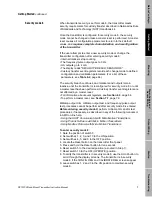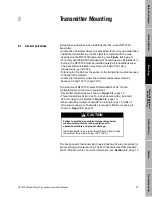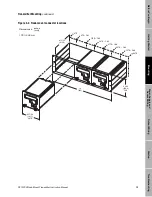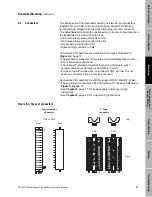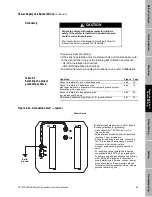
4
RFT9739 Rack-Mount Transmitter Instruction Manual
Getting Started
continued
Hazardous area
installations in Europe
To comply with CENELEC standards for hazardous area installations in
Europe, adhere to the following CENELEC conditions for safe use.
Location
The RFT9739 must be installed outside the hazardous area. The
transmitter installation must meet (at least) IP20 safety requirements,
per IEC 529.
Potential equalization
To achieve potential equalization, the RFT9739 ground conductor should
be connected to the appropriate ground terminals within the hazardous
area, using a potential equalizing line.
Output wiring
Nonintrinsically-safe connections between the RFT9739 and other
devices may be made
only
to devices that maintain a voltage less than
or equal to 250 V.
2.2
Configuration, calibration,
and characterization
The following information explains the differences among configuration,
calibration, and characterization. Certain parameters might require
configuration
even when
calibration
is not necessary.
Configuration parameters
include items such as transmitter tag,
measurement units, flow direction, damping values, slug flow
parameters, and span values for the milliamp and frequency outputs. If
requested at time of order, the transmitter is configured at the factory
according to customer specifications.
Calibration
accounts for an individual sensor’s sensitivity to flow,
density, and temperature. Field calibration is optional.
Characterization
is the process of entering calibration factors for flow,
density, and temperature directly into transmitter memory. Calibration
factors can be found on the sensor serial number tag and on the
certificate that is shipped with the sensor.
For configuration, calibration, or characterization procedures, see one of
the following communications manuals:
•
Using the HART Communicator with Micro Motion Transmitters
•
Using ProLink Software with Micro Motion Transmitters
•
Using Modbus Protocol with Micro Motion Transmitters
You can also use Fisher-Rosemount
™
Asset Management Solutions
(AMS) software for configuration, calibration, and characterization. For
more information, see the AMS on-line help.
A basic software tree for the HART Communicator is shown in
Appendix D, page 97.
Summary of Contents for Fisher Rosemount RFT9739
Page 1: ...Model RFT9739 Rack Mount Transmitter Instruction Manual Version 3 Transmitters February 2000 ...
Page 2: ......
Page 4: ......
Page 20: ...10 RFT9739 Rack Mount Transmitter Instruction Manual ...
Page 26: ...16 RFT9739 Rack Mount Transmitter Instruction Manual ...
Page 92: ...82 RFT9739 Rack Mount Transmitter Instruction Manual ...
Page 100: ...90 RFT9739 Rack Mount Transmitter Instruction Manual ...
Page 110: ...100 RFT9739 Rack Mount Transmitter Instruction Manual ...
Page 112: ...102 RFT9739 Rack Mount Transmitter Instruction Manual ...
Page 120: ...110 RFT9739 Rack Mount Transmitter Instruction Manual ...
Page 122: ...112 RFT9739 Rack Mount Transmitter Instruction Manual ...
Page 129: ......

















